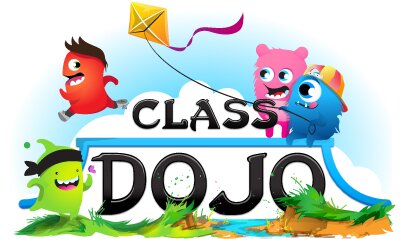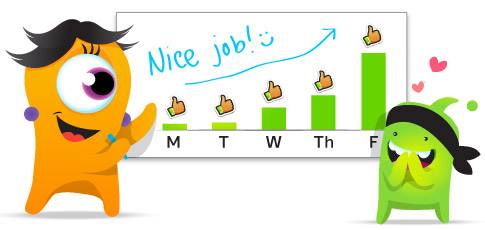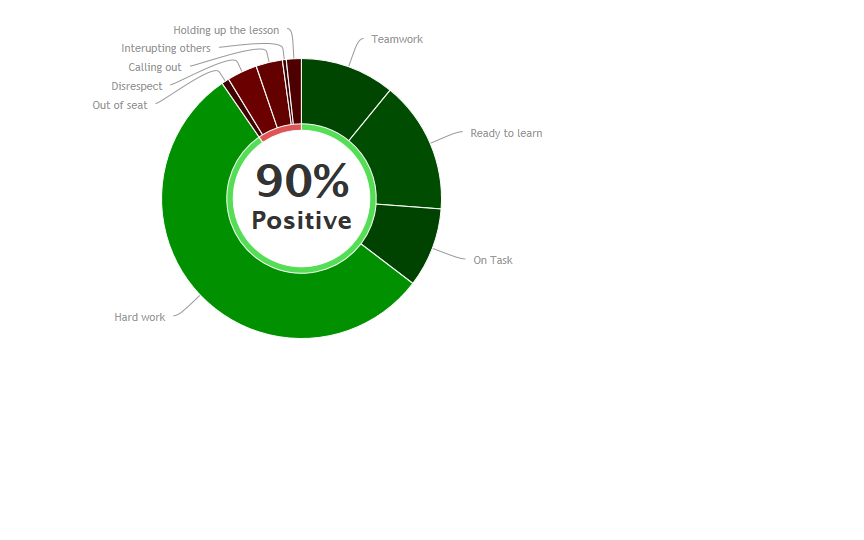MET:Classroom Management with Class Dojo
This page was originally authored by Rachel Sparks and Angela Isaac
Class Dojo is a free online classroom management tool that is based on a positive/negative point system. Teachers can use Class Dojo to track their students’ behaviour in the classroom. The point system is intended to encourage students to maintain positive behaviours and to moderate any negative behaviours.
| Class Dojo Inc. | 
|
|---|---|
| Type | Private |
| Foundation Date | 2011 |
| Location | San Fransico, California |
| Founders | Sam Chaudhary and Liam Don |
| Slogan | Behavourial Management Software |
| Website | www.classdojo.com |
| Type of Site | Educational Website |
| Registration | Required |
| Users | 10, 000+ |
| Countries | Over 120 |
| Languages | 29 |
| Status | Active |
History
Class Dojo was co-founded by Sam Chaudhary and Liam Don in 2011. Chaudhary was a high-school Science teacher, he also worked for McKinsey & Co in London. Don worked as a game developer for Runescape. Don left his PHD program in Computer Science to join Chaudhary to start Class Dojo. Chaudhary and Don were seed funded by the educational technology incubator Imagine K-12. The tool was created after hundreds of teachers were surveyed and reported classroom management as their biggest struggle in teaching. Class Dojo was founded to bring positive reinforcement and encouragement into the classroom rather than discipline and punishments.
Overall Benefits and Affordances
- The service is cost-free.
- Web-page is easy to navigate.
- Step-by step directions are given to teachers for creating a new Classroom Dojo class.
- Students are provided with a concrete measure of their behaviour.
- More teaching time and less time spent on classroom management.
- New consistent communication bridge between parents and teachers.

Features for Teachers:
- Positive behavioural management system.
- Generate data on individual students’ behaviours.
- Customize a set of positive and negative behaviour traits they do or do not want to see in their classroom (ex. positive = teamwork, negative = off-task).
- Timer that counts the time it takes students to transition from one activity to another.
- Timer to countdown the amount of time students need to work quietly.
- Display students’ points on interactive whiteboards.
- Connect to mobile so that points can be added from mobile devices.
- Build quantitative and qualitative evidence of student’s behaviours to show parents or administration.
- Track student’s attendance.
- Archive data of former classes from previous years.
- Organize points by subject.
- Weekly reports available.
- Comment boxes for in-depth feedback.
- Teacher support pages- to connect and share ideas with other teachers.
- School sign up- all students in a school can sign up to have a consistent behavioural management system in place.
- Less time spent managing the class, more time spent teaching.
- Less time spent inputting data into spreadsheets, more time spent planning.

Features for Students:
- Choose their individual avatar.
- Help create positive and negative behaviours.
- Track their own behaviour and progress during class time.
- Instant gratification with award notification sounds.
- Sign-in using their student code to view their points from home or mobile device.
- Compare their behaviour to classmates.
- Creates a competitive environment to increase student motivation.
- Possible opportunity to earn rewards or prizes or improved behaviours or Class Dojo challenges.

Features for Parents:
- Sign-in using their parent code to view their child’s points from home or mobile device.
- Trend spotters will point out re-occurring behaviours.
- Parents can view individualized comments and weekly reports.
- Can learn more about Class Dojo through easy to understand youtube videos.
 Theories Supporting Class Dojo:
Theories Supporting Class Dojo:
A reward system like Class Dojo can be successful because it encourages the development of students’ self awareness. Neurologist Dr. Judy Willis compares students’ reaction to reward systems like Class Dojo to playing video games. In video games, “feedback of progress is often ongoing, such as accumulating points, visual token, or celebratory sound effects.” Dr. Willis explains that the human brain is hardwired to respond to these forms of feedback with a release of dopamine, which ultimately leads to a sense of self-satisfaction. A similar response occurs when students receive Dojo points for positive behaviours. During class, students are given simple and clear feedback instantaneously, such as “Well done Linh! +1 for Helping Others.” Students are able to track their individual achievement and can more easily recognize any correct choices they make.
Skinner’s Theory of Positive Reinforcement supports this way of thinking. Skinner believed that educators should foster a learning environment where students feel empowered and are encouraged to develop by means of positive reinforcement. Skinner recommends that educators reinforce students’ behaviours through intrinsic rewards such as praise, and through various extrinsic rewards such as points or prizes. Class Dojo’s point system can be used as an extrinsic reward to reinforce positive behaviours.

Suggested Strategies for Implementing Class Dojo in the Classroom:
Skinner also strongly advocated against using punishment as a motivator. He believed the focus should be on reinforcing good choices, rather than punishing students for wrong behaviours. This concept is helpful when establishing how to effectively implement Class Dojo in the classroom. It is recommended that greater focus be placed on giving points as a reward and less focus should be placed on taking away points for punishment.
Critics of Class Dojo would argue that Class Dojo’s point system is not in the best interest of students. They suggest that it creates a stressful learning environment where students either feel pressure to earn the most points or feel defeated for losing points. Some students are easily discouraged by receiving negative points, particularly when their points are made public. When the founders conceived of Class Dojo, they had originally intended for it to be used mainly as a tool for motivating through positive reinforcement. It is important that teachers are careful not to only use the point system as a form of punishment. Intrinsic motivation is best achieved through encouragement.
Other educators suggest that Class Dojo offers limited feedback because the comments are quick and generic. The kind of feedback Class Dojo offers would likely not be enough for all students. As an educator, you would need to have individual conferences with certain students to ensure they understand how their behaviour is impacting the class. However, the benefit of Class Dojo’s quick and simple comments is that they are easily understood by all learners. Also, since educators do not always have time for one-on-one conferencing, Class Dojo can be used to reinforce the teacher’s expectations on a more regular basis.
Review of Criticisms:
- Public display of individual points can actually be demotivating for some students.
- The system might encourage students to compare themselves with other students.
- Universal comments such as “Well Done” do not provide students with specific feedback
- Ownership falls on the teacher to ensure points are distributed equitably and consistently
- Digital divide. Not all schools have the same access to the technology or the internet.
- Difficult to use with large class sizes.
- Less effective with older age groups.
Strategies for Confronting these Criticisms:
- Notifications can be changed so that negative points are not shown publicly.
- Randomize button helps to ensure equal distribution of points.
- Whole class points can be earned not just individual. The class can earn points to promote community building.
In sum, to effectively use Class Dojo, teachers should be aware of the negative effects it may have on individual students. Teachers should focus on community and character building strategies such as promoting positive reinforcement. Teachers need to distribute points equally through the consistent use of the randomize button to give all students a fair chance to gain points.
Future Trends
- Thousands of new users register weekly.
- Increased reports of positive student behaviour.
- Class Dojo will continue to go viral through social networking sites.
- Increased mobility of the service with smart phone applications.
- Potential for the development of adaptations that can be used for managing businesses
- Data and analytical reports provide trends of student behaviour will be used in future research studies of student behaviour.

Class Dojo was created in 2011 and since then it has become viral with tens of thousands of users across dozens of countries and is now available in multiple languages. It has evolved from a website to a mobile application that can be easily accessed anywhere by teachers, parents and students alike. As more theory and research is invested into Class Dojo, it will continue to become more effective.
Stop Motion Animation
Animation added by Michael Grieve, Feb 2015 Video highlighting the concept
Classroom Management with Class Dojo by Saniya Uraizee, Jan 2018 Video highlighting the concept
References:
1. 30 under 30. Forbes Magazine. Retrieved from http://www.forbes.com/pictures/lml45mkil/sam-chaudhary-26-and-liam-don-26-cofounders-class-dojo/
2. Beta Classroom. Class dojo review. Retrieved from http://betaclassroom.wordpress.com/class-dojo-review/
3. Classroom management theorists and theories/burrhus frederic skinner (2013,10, 4). Retrieved from: http://en.wikibooks.org/wiki/Classroom_Management_Theorists_and_Theories/Burrhus_Frederic_Skinner
4. Carr, J. (2012, 09, 10). Class dojo launches first smartphone app. Wired Cosmos. Retrieved from: http://wiredcosmos.com/2012/09/10/classdojo-launches-first-smartphone-app/
5. Ed Tech. (2012, 08, 17). Class dojo goes viral. Getting Smart. Retrieved from: http://gettingsmart.com/2012/08/class-dojo-goes-viral-raises-seed-round/
6. Lon, C. (2013, 10). How to corral a chaotic class. National Education Association. Retrieved from: http://www.nea.org/home/56816.htm
7. Martin, A. (2013, 12, 1). Educational app helps parents track kids’ behaviour. The Miami Herald. Retreived from: http://www.miamiherald.com/2013/12/01/3791558/educational-app-helps-parents.html
8. Teaching Ace. (2013). Thinking about class dojo - why not just tase your kids instead? Retrieved from: http://www.teachingace.com/thinking-about-classroom-dojo-why-not-just-tase-your-kids-instead/
9. Williams, E. (2012, 06, 17). Give us a point please. Daily Examiner Grafton. Retrieved from: http://www.highbeam.com/doc/1P2-33229322.html
10. Willis, Judy. (2011, 04,14). A neurologist makes the case for the video game model as a learning tool. Retrieved from: http://www.edutopia.org/blog/video-games-learning-student-engagement-judy-willis
References added for Stop Motion Video
1. Byrne, R. (2012). Classroom Management Made Fun. School Library Journal, 58(11), 15.
2. Class dojo goes beyond behavioral rewards and into 'growth mindset'. (2016). Curriculum Review.
3. MacLean-Blevins, A. O. Class DoJo: Supporting the art of student self-regulation. Retrieved from: http://aprendercom.org/escola21/file/download/3513
4. O'Brien, C., & Aguinaga, N. (2014, March). Using Class Dojo with an Interactive Whiteboard and iPad Projection to Promote Positive Behavioral Interventions and Supports at the Classroom Level. In Society for Information Technology & Teacher Education International Conference (Vol. 2014, No. 1, pp. 2931-2933).